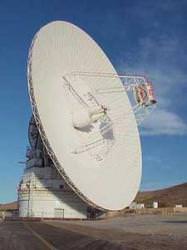As the Beatles strummed the opening notes to “All My Loving” on the Ed Sullivan Show 50 years ago yesterday, few could have imagined how wide-ranging that music would be. The broadcast gave birth to a global music phenomenon. And like all TV broadcasts of the day, the music carried out into space at the speed of light.
The Inside Science infographic above (see below for the full version) traces the history of the Beatles in relation to how far the broadcast travelled in that time. While those waves were washing out, er, across the universe, the Beatles have been taking over human space exploration in other ways. Below the jump are seven of the more memorable moments.
Rocking The Space Station With ‘Back at the ISS’
Technically speaking, this isn’t the Beatles, but it sure was inspired by them. ‘Back at the ISS’ — the remake of ‘Back in the U.S.S.R.’ by Dutch band Love & Mersey — is about a billion shades of awesome. Not only because of the lyrics, not only because of the high-energy space-themed video, but also because they sang in three languages. The song was released in March 2012 as a “rocking musical greeting” to Andre Kuipers (a European Space Agency astronaut) and the rest of the Expedition 30 crew days before the docking of the Automated Transfer Vehicle Edoardo Amaldi that month.
Beatles In The Sky With … Asteroids
Yup, there’s an asteroid named after the Beatles. Oh yeah, there are also asteroids named after members John Lennon, Paul McCartney, George Harrison and Ringo Starr.
Good Morning Good Morning wake-up calls
The Beatles have been used to wake up several shuttle crews, and also the Curiosity rover. Explained Eric Blood, Curiosity’s surface systems engineer: “She tends to be less cranky with a good wakeup song.”
Playing (And Drinking?) English Tea In Space
Here’s Paul McCartney in 2005 casually playing two tunes to the Expedition 12 crew — NASA astronaut Bill McArthur and Russian cosmonaut Valery Tokarev — during a live concert. It’s a bit hard to tell who had bigger stars in their eyes after the experience. “I told the audience ‘I think I need about 20 minutes to go have a lie down,’ McCartney stated in a NASA release from the time. “What do you do after that? We haven’t stopped talking about it since.”
Roll Over Beethoven: How The Beatles Almost Made Voyager’s ‘Golden Record’
Remember when scientists announced last year that Voyager 1 entered interstellar space? On board the spacecraft was a Golden Record intended to give aliens a glimpse into what Earth’s life is like. Included were songs from artists ranging from Bach to Blind Willie Johnson, but not the Beatles. They were almost included, though, as astronomer Carl Sagan (who chaired the selection committee) explained in his 1978 book Murmers of Earth. “We wanted to send ‘Here Comes The Sun’ by the Beatles, and all four Beatles gave their approval. But the Beatles did not own the copyright, and the legal status of the piece seemed too murky to risk,” he wrote.
Joining Mr. Mercury’s Light
There are so many earthly memorials to John Lennon after the singer’s untimely death in 1980, but late last year he got an extraterrestrial honor. Lennon was among 10 names approved for craters on the planet Mercury. “It’s unlikely that Mercury’s surface is populated with tangerine trees and marmalade skies, but the famous British musician who coined that phrase now has a physical presence on the planet closest to the Sun,” NASA said.
Sending Love To The Aliens With Jai Guru Deva Om
February 4, 2008 marked the first time NASA beamed any song into deep space, and what better choice than “Across The Universe”? The date marked the 40th anniversary of when the Beatles recorded the song, and came around the same time as the 45th anniversary of NASA’s Deep Space Network and the 50th anniversary of NASA’s first satellite, Explorer 1, among other milestones. In a statement, McCartney asked to “send my love to the aliens.”
What Beatles milestones in space have we missed? Let us know in the comments.


